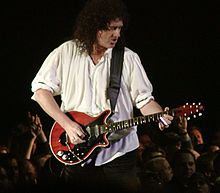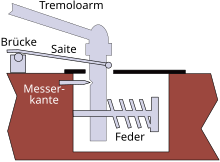Red special
Red Special (or the Fireplace , May himself calls it Old Lady ) is the name of Brian May's guitar, which was made in the 1960s from parts that were to be found in the May house at the time, including the mahogany wood of a fireplace, a bread knife and parts of a motorcycle. Although it was originally only intended as a replacement for the guitar of choice by the young Brian May, who initially wanted a Fender Stratocaster or a Gibson Les Paul , May has since used this guitar almost exclusively, both in the studio and live.
May began building the guitar in August 1963, at the age of sixteen, together with his father, an electronics engineer, and it was completed after 18 months. For this purpose, father and son built an amplifier and an echo machine . After the guitar was reproduced in series for a short time by the Guild company in the early 1980s and again in the early 1990s, the “Burns” company also brought a “signature model” onto the market in the late 1990s. In the meantime May is marketing the production himself under the name “Brian May Guitars”, under which the new edition of the “Red Special” was published in 2006.
features
The structural peculiarities of this electric guitar allow May to produce a wide variety of sounds and the typical singing sound. (See Queen .)
- The fingerboard is quite wide compared to other electric guitars (especially on the saddle) and has 24 frets, which was rather unusual at the time.
- The shape of the body is based on the semi-acoustic guitars of the time, such as the Gibson ES-335 . It is made of oak and is veneered with red- stained mahogany. Similar to a semi-acoustic guitar, cavities are incorporated into the body as acoustic chambers, which amplify certain frequencies through resonance and thus produce the characteristic sound of this guitar.
- The neck consists of a 120-year-old transom from a chimney, it even has holes made by woodworms. As with most electric guitars, a neck tensioning rod is also incorporated into the neck to counteract the tension of the strings and thus the bending of the neck.
Pickup system
Since the then commercially available string pickups were designed in such a way that there was as little feedback as possible, May tried to make them himself. Since the results were unsatisfactory, he used three Tri Sonics single-coil pickups from a Burns Vibra Artist guitar (built in 1961/62). They consist of magnetic cores each with 4000 turns of telephone wire. This gives them a higher degree of efficiency. Since May likes to play at such high volumes that feedback effects occur, they are encased in synthetic resin to avoid the unpleasant feedback whistling. The three pick-ups are attached to precisely calculated positions, which significantly influences the sound of the guitar. Theoretically, they can be interconnected in 26 different ways, as each pickup can not only be switched on or off individually, but also in phase or out of phase with the other pick-ups.
May most often uses the combination of bridge and center pickup in phase, which creates a sound similar to that of a humbucker in the bridge position. The thin, screaming solo sound in “ Bohemian Rhapsody ”, on the other hand, is the result of the anti-phase combination of neck and middle pickup.
electronics
Brian May also uses a so-called “treble booster” which Pete Cornish once soldered together for him after May's Rangemaster, who can still be heard on the first Queen records, was lost at a concert. This “treble booster” was later improved by Greg Fryer. In addition, a 1-watt mini-amplifier can often be heard during his studio recordings, which was then made by Queen bassist John Deacon from electronic waste and an old speaker box. This amplifier is affectionately called "Deacy Amp" and makes a decisive contribution to the typical Brian May sound.
Tremolo system
The tremolo of the Red Special consists of a steel block that is rotatably mounted on a knife edge. Two springs counteract the tension of the strings. The springs originally came from the valve train of an old Panther motorcycle from 1928, the knife edge was actually an old bread knife from May's mother. The tremolo block and bridge are separated by about 6 cm.
By separating the tremolo and the bridge, the strings on the bridge are severely kinked. In many commercially available guitars, this kink causes the strings to generate friction when the tremolo moves on the bridge . On the one hand, this friction causes the guitar to quickly go out of tune , and on the other hand, there is an increased risk of the string breaking at the kink. That is why May - a novelty in guitar making - installed small rollers in the bridge, over which the strings are deflected. The frictionless unwinding increases the service life of the string and makes the system more stable.
Style of play
Brian May turns up the volume so much that the sound of the guitar becomes independent due to the feedback effects . However, in order to still enable controlled play, the feedback must not take place between the electromagnetic fields of the loudspeakers and the pickups (pick-up feedback), but between the mechanical vibrations of the loudspeaker membrane and the strings that are conveyed by the sound waves (strings Feedback).
All the structural peculiarities of his guitar alone do not explain the special sound. May classified the sound of his guitar between that of a typical Fender and that of a typical Gibson guitar. May's touch technique is mainly responsible for the sound . Instead of a pick , May used old English sixpence coins for a long time , which provide a more overtone-rich tone when struck than with ordinary picks. As a contrast to this, he plucks the strings with the index finger of his right hand on some solos (including the piece Last Horizon ) and thus creates a warm sounding tone.
literature
- Brian May, Simon Bradley: Brian Mays Red Special , Hal Leonard Books, October 2014, ISBN 9781480341470 .
Web links
- Brian May Guitars - Official Website (English)
- www.brianmayworld.com: Red Special (English)
- The circuit of the "Red Special" (German)
- Guitar Player , January 1983, interview by Jas Obrecht with Brian May
credentials
- ↑ that sound? theguardian.com: Hey, what's that sound: Homemade guitars
- ↑ a b youtube.com: Brian May's Red Special - The Book Launch
- ^ The brian may special user information. (PDF; 195 kB) (No longer available online.) Brian May Guitars, archived from the original on September 28, 2011 ; accessed on December 31, 2011 .



